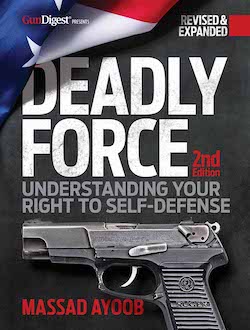Our ninth member education item, the second edition of a 332-page book by Massad Ayoob, is the most expensive to procure of the many educational items the Network sends members, but the investment in member knowledge is well worth it, creating members who are less likely to make errors of judgment or to give misleading details while handling the legal aftermath.
Educated about both the law and society’s negative reaction to using force–even in undeniable self defense–Network members reading this book will be even quicker to avoid situations that might lead to a fight.
 However, if preclusion fails and a Network member is forced to choose between using a gun for defense or death or crippling injury, the member must understand the legal aftermath that will follow. “Know the standards to which you will be held,” Ayoob urges early in Deadly Force, but the reader may wonder in a time where layers upon layers of law and precedence have been imposed upon the basic human right to self defense, how can a layperson obey that advice?
However, if preclusion fails and a Network member is forced to choose between using a gun for defense or death or crippling injury, the member must understand the legal aftermath that will follow. “Know the standards to which you will be held,” Ayoob urges early in Deadly Force, but the reader may wonder in a time where layers upon layers of law and precedence have been imposed upon the basic human right to self defense, how can a layperson obey that advice?
Indeed, some have asked, “Why not leave understanding how to defend self defense to your lawyer?” Introducing his chapter on commonly misunderstood aspects of self-defense incidents, Ayoob sums it up thus, “If you keep or carry a firearm for defensive purposes, you are a potential victim of an unjust accusation based on legitimate actions that will need expert testimony so the jury can properly and fairly interpret the evidence to determine the facts. It will be hugely helpful in court – and to your decision-making ability at the danger scene itself – for the law-abiding armed citizen to understand these things beforehand.” He goes on to educate the reader about the many facts that police, prosecutors, judges and juries must weigh before finding the armed citizen’s use of force lawful and justifiable.
Following a tradition established through his 40 years of teaching, Ayoob first distills the elements that must be present to justify use of deadly force and then explains each in the same words you and I might use in daily conversation. Each element of justification is illustrated through stories of the defendants on whose trial teams Ayoob has served as an expert witness. For example, while “mantle of innocence” may be used by lawyers to explain that a client avoided escalating an argument leading up to an attack against them, Ayoob writes that one who fails to preserve their innocence “kept the ball rolling” in a confrontation and will be judged to bear some responsibility for being part of the conflict. He gives “bare fear” and “reasonable fear” the same treatment in colorful terms that stick in the mind and later does the same for the Latin malum prohibitum and malum in se and for the doctrine of necessity.
An important side effect of knowledge is increased confidence when you have no choice but to resort to lethal force to remain alive. In his chapter on what constitutes an assailant’s ability to kill or cripple, Ayoob details knife and bludgeon lethality, explaining how employing a firearm in defense against either may be painted as excessive. The reader comes away further convinced of the necessity of being able to stop non-gun attacks quickly and decisively.
Nowadays Internet arguing is a high art form and discussions between those genuinely interested in uncovering the truth are often interrupted by online trolls who dispute the facts then challenge, “Show me the court cases.” Well, Deadly Force is replete with the court cases that illustrate fundamental elements like disparity of force, the Tueller principle, the reasonable person standard, the affirmative defense and how to present those and other truths to the skeptical. Ayoob often quotes defense attorneys, prosecutors, trial judges, witnesses, and sometimes Ayoob’s own expert witness testimony as he cites principles he explained at trial in defense of one who used guns to save his or her own life.
The Network's leadership team believes this book is invaluable as a documentable resource that clearly defines in today’s terms when deadly force is justifiable. Deadly Force also provides citations to more in depth reference works on the various topics it covers. While it’s tempting to say this book is the ultimate resource for this topic, the book’s footnotes point out just how much more study material is available for the dedicated student of self defense.
Network members are serious about understanding that just shooting accurately is not enough and know that being able to articulate the reasons that shooting was necessary is also critical. At the core of the Network’s mission is fostering our members’ understanding of “when and why,” which is just as important as “how” to defend self and family. That is why Massad Ayoob’s Deadly Force: Understanding Your Right to Self-Defense is an integral part of the educational series we send every Network member.
All of us here at the Network turn to Ayoob for reliable training, and when asked her thoughts after reading the most recent edition of Deadly Force our membership/customer service team member penned these thoughts:
The 2nd Edition of Massad Ayoob’s book Deadly Force is an integral piece of the education package we send out to every Network member. The price of including the book in the package is an excellent investment in our member education.
In the forward, 1991-92 president of the National Association of Criminal Defense Lawyers Jeffrey Weiner states, “There are those who talk the talk and those who walk the walk. Massad Ayoob is among the rare few who fall in the latter category.” This is followed by a chapter on Massad’s extensive background in law enforcement, firearms training and expert witness work as well as being a published author. Ayoob adds, “For this second edition of Deadly Force, I have experienced eight more years in the courts and gathered information from other cops and private-sector instructors who teach in this area, including many more attorneys and cases in which I’ve been an expert witness and advisor on trial strategy.”
I had the great privilege to take Massad Ayoob’s MAG-40 training last summer. It was incredible and I learned so much in both the lecture portion as well as the live-fire training. Most of the material covered in the lecture portion of the training is in print in Deadly Force.
He begins by going over the standards of the courts regarding deadly force, stating “If you act to the standards by which you know you will be judged, you should not be found wanting in judgment.” If you have studied and educated yourself on those standards, it will be most helpful in both your decision making ability on the scene as well as navigating self-defense in the court process.
Most understand the precept of reserving deadly force for threats of immediate danger of death or great bodily harm, but this book delves into the elements of ability, opportunity and jeopardy. An element of each must be present to justify deadly force. There is a chapter dedicated to each breaking down the criteria, such as various weapons, disparity of force, distance and the Tueller drill and recognizing pre-attack indicators.
If you attend his class or read this book, you learn that Massad is a walking encyclopedia of case law that illustrates fundamental elements such as the reasonable person standard, the doctrine of necessity and affirmative defense. Not to worry, he writes in layman’s terms for all to understand.
Studying prior cases is a worthwhile educational tool and this book does not disappoint. There are chapters on both the case of FL v Zimmerman and AZ v Hickey. These chapters are full of an excellent summary of the evidence and trial details as the author was involved in these cases as either an expert witness or consultant.
A great addition to this second edition are chapters on the Rittenhouse case and the Arbery case, as well as a chapter on the SCOTUS NY v Bruen opinion. There are lessons to be learned from all these cases and they are well documented.
The final chapters discuss what to expect if you find yourself in the middle of a controversial or high-profile case and the five-point checklist of what to say to police after a self-defense shooting. In the appendix there is an article about the Psychological Aftermath of a Citizen’s Use of Lethal Force by Anthony H. Semone, PhD. The book ends with excellent bonus material such as attorney selection, concealed carry advice and latest trends; such as media and riots.
The information and educational content of this book is unrivaled, in my opinion. This book is essential if you carry a firearm and wish to be educated on all aspects of lethal force laws.
For previews of the our Network member education videos, click here.
